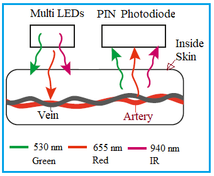Photodiode Array (PDA): Definition and How It Works
Advertisement
A photodiode array (PDA) is a semiconductor device comprised of an array or grid of photodiodes. Each photodiode in the array is designed to convert light into an electrical current. Photodiodes are a specific type of photodetector that operates using reverse bias. A typical photodiode array consists of many individual photodiodes arranged in a matrix of rows and columns.
The array configuration is beneficial because it allows for the simultaneous detection of light at multiple wavelengths, or from different spatial locations. This makes photodiode arrays incredibly versatile components for various applications, including spectroscopy, imaging, and sensing.
Photodiode Array (PDA) Detector: How it Works
A Photodiode Array (PDA) detector is commonly used in analytical instruments such as spectrophotometers and chromatography systems. At its core, the PDA detector contains an array of individual photodiodes, where each photodiode is sensitive to a particular, specific wavelength of light.
The key feature of the PDA detector is its ability to simultaneously measure the intensity of light across a range of wavelengths. This is especially helpful in applications such as UV-Visible spectroscopy and high-performance liquid chromatography (HPLC).

Let’s dive into the working principle of a Photodiode Array (PDA) detector:
- Light Interaction: When light passes through a sample (or flows through a chromatographic column), it interacts with the analyte (the substance being measured). Some of this light is absorbed by the analyte, and the remaining light reaches the PDA detector.
- Wavelength Response: The incident light then falls on the array of photodiodes. Each photodiode in the array is designed to respond to a different wavelength of light. This response is based on the photoelectric effect: photons striking the semiconductor material create electron-hole pairs.
- Charge Generation: The absorbed photons generate electron-hole pairs within the semiconductor material of each photodiode.
- Current Generation: The generated charge carriers create a current. Critically, the current’s strength is proportional to the intensity of the incident light at the specific wavelength that the photodiode is sensitive to.
- Signal Conversion: The currents generated by each photodiode are converted into electronic signals.
- Spectrum Production: These signals are processed to create a spectrum. This spectrum represents the distribution of light intensity across the entire range of wavelengths being measured.
- Analysis: The resulting spectrum provides information about the absorption or emission characteristics of the sample. This depends on the type of analysis being performed. For example, in chromatography, the spectrum can reveal the presence and concentration of different compounds in a mixture.
One of the most significant advantages of PDA detectors is their ability to detect light at multiple wavelengths simultaneously. This enables the rapid acquisition of a complete spectrum, rather than having to measure one wavelength at a time.
Benefits and Advantages of Photodiode Arrays
Here’s a breakdown of the key benefits and advantages of using photodiode arrays:
- Simultaneous Detection: The array configuration allows for the simultaneous detection of light at multiple wavelengths or from different spatial locations.
- Fast Response Time: Photodiodes offer a fast response time, allowing for quick detection of changes in light intensity. Therefore, they’re well-suited for applications that need rapid measurements or real-time monitoring.
- Low Noise: Photodiode arrays often exhibit low noise characteristics, making them useful for accurate and precise measurements in scientific and analytical applications.
- Compact Size: Photodiode arrays can be manufactured in compact sizes, which makes them suitable for integration into various devices, components, and systems.
- High Quantum Efficiency: Photodiodes offer higher quantum efficiency, meaning they can efficiently convert incident photons into electrical signals. This makes them preferred for applications requiring low light level detection.
- Cost-Effective: Photodiode arrays are cost-effective due to mass production and advancements in semiconductor fabrication technologies. This leads to their use in a wide range of applications.
In summary, the Photodiode Array (PDA) detector enhances the speed and sensitivity of analytical instruments (like spectrophotometers and chromatographs) with its simultaneous multi-channel spectrum capture. Its ability to quickly acquire spectral data makes it valuable for diverse applications in analytical chemistry. Their ability to detect light across multiple wavelengths simultaneously, along with their fast response times and compact designs, makes them valuable in various scientific, industrial, and consumer electronics applications.
Advertisement
 RF
RF







